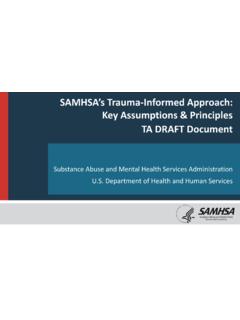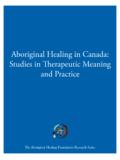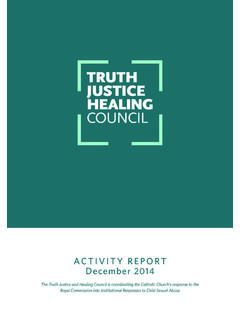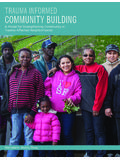Transcription of Creating Pathways for the Dreams of our Children ...
1 Little Drum Consulting Creating Pathways for the Dreams of our Children ~. aboriginal early childhood development and Care "Let us put our minds together and see what kind of life we can build for our Children ". ~Sitting Bull~. Authors: Alison Gerlach Monique Gray Smith Joyce Schneider Funding for this paper was provided by the Ministry of Children and Family development Little Drum Consulting About the Authors Alison Gerlach, MSc, OT(C). In her journey as a Non- aboriginal , independent consultant, Alison draws on 20 years of supporting and learning from families and Children with special needs as an occupational therapist. Over the past 10 years, Alison has been privileged to have partnered with several First Nations and aboriginal communities and agencies in on early intervention, school therapy, program development , cultural safety and community development .
2 These experiences led to her writing Steps in the Right Direction: Connecting & Collaborating in early Intervention Therapy with aboriginal Families & Communities in . Alison's ongoing learning of aboriginal worldviews informs and enriches her personal life, including the raising of her two sons, and her professional commitment to building trust, partnerships and social justice. Monique Gray Smith, Psychiatric Nurse Monique is a mixed heritage woman of Cree, Lakota, and Scottish descent, and at the time of writing this paper her twins were 4 years old. Her formal training is as a Psychiatric Nurse and her work experience has been in the areas of aboriginal Education; with a focus on the early Years; Stress and Trauma Recovery, and Staff development . She is the owner of Little Drum Consulting and the author of the aboriginal Infant development Programs Policy & Procedure Manual and the aboriginal Supported Child development Handbook.
3 Monique has had the privilege to work in and learn from numerous communities across Canada, as well as overseas. She has been sober and involved in her healing journey for over 17 years; and this year has embarked on a new aspect of her healing; learning her Cree language. Joyce Schneider, MA. Joyce is a member of the St at imx Nation, granddaughter of Kikya7, and mother to 3 boys and one girl. She completed her master s degree in First Nations Studies at UNBC in April of 2007. with a GPA of Since then she has instructed in an aboriginal university preparation program and contributed to numerous aboriginal early years curriculum research and development projects as a sub contractor for Little Drum Consulting. Joyce is currently working on a curriculum Indigenization framework for the province of BC and developing curriculum that is relevant and appropriate for aboriginal adult learners.
4 In her private consultation work Joyce strives to offer her skills where they will best contribute to the continuing growth and development of strong, vibrant and healthy aboriginal communities, particularly in the area of education. 2 Creating Pathways for the Dreams of Our Children : aboriginal early childhood development and Care: Gerlach, Gray Smith, Schneider, 2008. Little Drum Consulting Table of Contents Content Page About the Authors 2. Executive Summary 4. Section 1: Preparing for the Journey 6. Entering the circle 7. Realizing the Dream, Why Now, Why the Importance? 8. Section 2: Pathways to Understanding the Dreams for Our Children 10. aboriginal Peoples 10. aboriginal Children , Families and Communities 11. aboriginal Languages, Knowledge, Wisdom & Traditions 14. aboriginal Self Determination 16. Targeted Programs for Infants and Children 17.
5 Section 3: Many Paths: Learning from Others 19. New Zealand 20. Cuba 23. Australia 26. Norway 29. Scotland 30. Learning from All Models 31. Section 4: Pathways to Strengthening the Dreams for Our Children 32. An aboriginal Voice 33. Strengthening through aboriginal Knowledge 33. Strengthening aboriginal Languages 34. Strengthening Community 35. Strengthening ECD Education 37. Strengthening Funding 38. Strengthening Models of Service Delivery 40. Strengthening Self Governance and Policy 42. Strengthening Outcomes 43. Accountability 44. Section 5: Considerations for entering the circle again 45. References 46. 3 Creating Pathways for the Dreams of Our Children : aboriginal early childhood development and Care: Gerlach, Gray Smith, Schneider, 2008. Little Drum Consulting EXECUTIVE SUMMARY. Purpose The purpose of this preliminary discussion paper is to provide information and an initial direction to the Ministry of Children and Family development ( ) for the development of an aboriginal early Years Strategic Framework.
6 The focus of this discussion paper is Aboriginal1 Children , their families and communities in British Columbia ( ) inclusive of on and off reserve populations. The scope is initiatives from preconception to 6 years of age, framed within the context of a community development approach. There are a variety of terms being used within our province to describe working with aboriginal Children . For the purpose of this discussion paper we are using the inclusive term of early childhood development and Care ( ). Methodology A selection of interdisciplinary written literature and web-based information was reviewed from provincial, national and international sources. This included work by aboriginal and non- aboriginal scholars, a review of some early Years initiatives in other countries with indigenous populations, and of prominent papers that are guiding the government in their new relationship and commitment to aboriginal Children and peoples in this province.
7 The authors believe that is only one part of a child s learning and that any strategic planning must recognize the role of Elders, family, community, culture and language in teaching and learning. The allotted time of just over 3 weeks to research and write this paper, did not allow for the writers to honour traditional ways of knowledge gathering or community consultation. As such, they are very cognizant that the primary weakness of this paper is the absence of traditional ways of knowledge gathering and community engagement. At a Glance For ease of reading this paper has been divided into 5 sections which we invite you to read in their entirety as they provide in rich detail knowledge and wisdom which the authors hope will inform and guide the development of a strategic plan. Section 1: Preparing for the Journey In this introductory section you are invited to join the circle.
8 This will involve you discovering, or rediscovering, the importance of the Indian Residential School Apology on June 11, 2008. In Realizing the Dream: Why Now, Why the Importance? you will review a synopsis of some of the work and initiatives related to undertaken in over the last ten years, that has lead to the current opportunity for an aboriginal early Years Strategic Framework . 1. For the purposes of this paper, the term aboriginal refers collectively to the indigenous inhabitants of Canada, including First Nations, M tis, and Inuit peoples. 4 Creating Pathways for the Dreams of Our Children : aboriginal early childhood development and Care: Gerlach, Gray Smith, Schneider, 2008. Little Drum Consulting Section 2: Pathways to Understanding the Dreams for our Children Common themes (or Pathways ) create a cultural, linguistic, socioeconomic and historical landscape for you to better understand the Dreams for our Children .
9 This understanding is foundational for all involved in policy and decision-making for aboriginal early Years. Section 3: Many Paths Learning from Others The development of a meaningful aboriginal early Years framework would not be complete without the inclusion of best practices that have been or are currently being implemented in other parts of the world. This section introduces you to a sampling of diverse models of service delivery from New Zealand, Australia, Cuba, Norway and Scotland. It concludes with common themes that are shared by the various models highlighted in this section. Section 4: Pathways to Strengthening the Dreams of our Children The Pathways in this section will highlight for you common themes that emerged from the literature review. We suggest ways to ensure that we are all on the same path, going in the same direction towards: aboriginal Voice aboriginal Knowledge aboriginal Languages Community early childhood development Education Funding Models of Service Delivery Self Governance and Policy Outcomes Accountability Section 5: Considerations for Entering the Circle Again In coming to the end of reading this initial discussion paper, we invite you to enter the circle and to reflect on how the themes from this initial discussion paper can inform and guide the development of an Initial aboriginal early Years Strategic Framework.
10 Recurring themes that have emerged to guide this process highlight the importance of: Remembering that 'families and Children ' are at the centre of all circles; inclusive of an aboriginal worldview of an extended family and community network of support. Planning and funding integrated and accessible services for all aboriginal Children and families; regardless of jurisdiction. Ensuring all policies, programs and services for aboriginal Children and families are rooted in diverse aboriginal cultures, languages and worldviews. Raising and educating aboriginal Children in a holistic manner (emotionally, physically, spiritually, and mentally) that focuses on their innate strengths. Engaging communities and supporting self-determination in all elements of early years programs and services; planning, implementation, and accountability. 5 Creating Pathways for the Dreams of Our Children : aboriginal early childhood development and Care: Gerlach, Gray Smith, Schneider, 2008.







